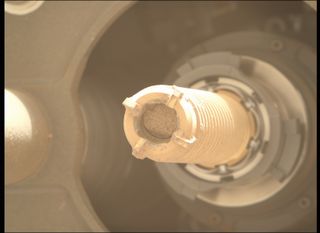
NASA's Perseverance rover has now collected a dozen Martian rocks.
The car-sized Perseverance drilled out and sealed up its 12th rock sample on Wednesday (Aug. 3), mission team members announced via Twitter today (Aug. 5) — its fourth such operation in less than a month.
In February 2021, Perseverance landed with NASA's tiny Ingenuity helicopter on the floor of the 28-mile-wide (45 kilometers) Jezero Crater, which harbored a big lake and a river delta billions of years ago. The six-wheeled rover is hunting for signs of ancient Mars life and bagging up dozens of samples for future return to Earth, among other tasks.
Related: 12 amazing photos from the Perseverance rover's 1st year on Mars
The first eight rock samples that Perseverance collected — from September 2021 to March of this year — were volcanic in origin, according to the mission team's sample log. But the last four, which were gathered between July 7 and Wednesday, all come from sedimentary rocks.
As that change suggests, Perseverance is now exploring a remnant of the delta, examining layered rock formations that built up over time as silt fell out of Jezero's ancient river. Such deposits are more likely than volcanic ones to harbor organic compounds and other possible signs of Mars life, if it ever existed, Perseverance team members have said. So it's not surprising that the sample-collecting pace has now picked up.
Perseverance carries a total of 43 sample tubes, 38 of which can be filled with Martian rock and dirt. The other five are "witness tubes," which will help the mission team determine which materials, if any, in collected samples may be contaminants from Earth.
Get the Space.com Newsletter
Breaking space news, the latest updates on rocket launches, skywatching events and more!
Perseverance has now sealed up 15 of those 43 tubes. Twelve contain rock cores, one holds Martian air, and the other two are witness tubes. (The "atmospheric sample" was sealed in the aftermath of Perseverance's abortive first rock grab, an August 2021 attempt that failed when the drilled material crumbled to bits.)
These tubes will be brought to Earth by a joint NASA-European Space Agency (ESA) campaign, perhaps as early as 2033. The architecture of that campaign changed recently; NASA and ESA decided to eliminate an ESA-provided "fetch rover" and rely instead on Perseverance and, if needed, two Ingenuity-like helicopters to deliver the sample tubes to the NASA rocket that will launch them off the Martian surface.
Mike Wall is the author of "Out There" (Grand Central Publishing, 2018; illustrated by Karl Tate), a book about the search for alien life. Follow him on Twitter @michaeldwall. Follow us on Twitter @Spacedotcom or on Facebook.
Join our Space Forums to keep talking space on the latest missions, night sky and more! And if you have a news tip, correction or comment, let us know at: community@space.com.

Michael Wall is a Senior Space Writer with Space.com and joined the team in 2010. He primarily covers exoplanets, spaceflight and military space, but has been known to dabble in the space art beat. His book about the search for alien life, "Out There," was published on Nov. 13, 2018. Before becoming a science writer, Michael worked as a herpetologist and wildlife biologist. He has a Ph.D. in evolutionary biology from the University of Sydney, Australia, a bachelor's degree from the University of Arizona, and a graduate certificate in science writing from the University of California, Santa Cruz. To find out what his latest project is, you can follow Michael on Twitter.
